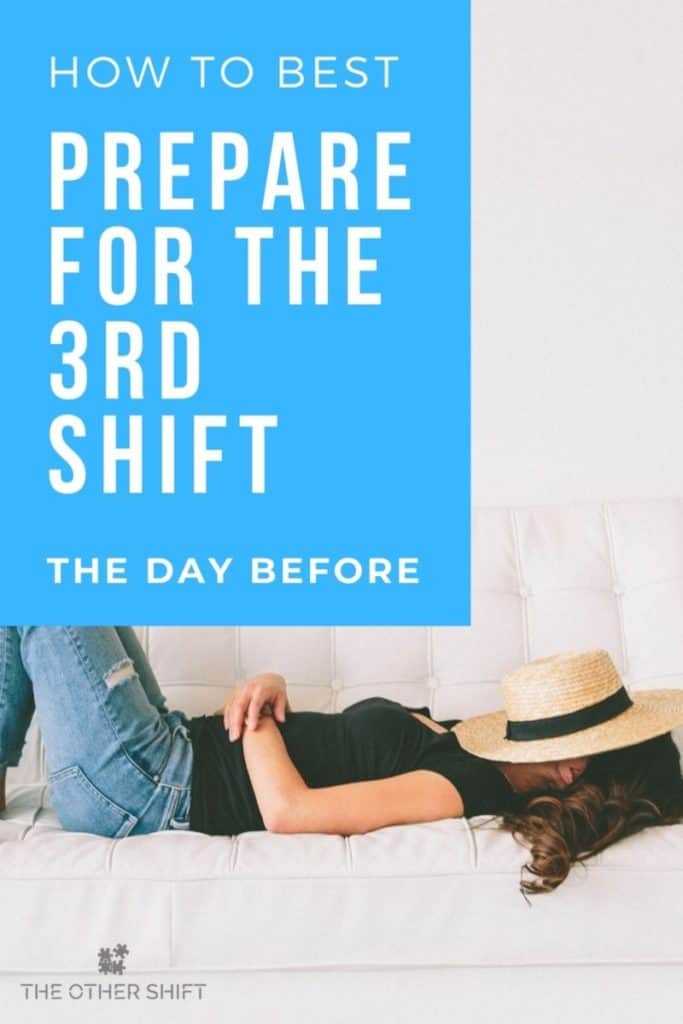Disclosure: This page may contain affiliate links, meaning we receive a commission if you decide to make a purchase through our links, but this is at no additional cost to you. Please read our disclosure and privacy statement for more info.
Should I stay up till the early hours, the evening before night shift? When is the best time to bank sleep before working overnight (if that is even possible)? Does an afternoon sleep before starting nights make a difference? Keep reading as we de-bunk the rumors and give you a practical guide for your next run of nights.
One technique, when preparing for night shift is to taper your sleep in the days leading up to your first night shift. You are trying to mimic the 3rd shift schedule. Another method is to sleep regularly the day of your first shift, then nap in the afternoon. At a minimum though, adequate sleep is critical to avoid being awake for a dangerously extended period of time.
Though there is no one right way to prepare for the night shift, one thing is for certain – preparing or at least considering the impact night shift is about to have on your body clock is vital. Ignoring the body’s sleep needs when working nights can lead to some nasty outcomes, but luckily they are avoidable.
Regardless of the technique you choose, getting 7-9 hours sleep (even if broken into parts) should always be your aim. Let’s review 3 techniques to allow you to decide what will work best for you.
If you are interested in checking out the best eye mask we use to make night shift sleep easier, click here.
1. Taper Your Sleep
Though it’s impossible to bank sleep, we can train our body to sleep or be awake at times when it normally wouldn’t. (Because as we know, working the overnight shift goes against our body clock and what we are naturally programmed to do.)
In essence, when tapering your sleep, this technique continually moves your bedtime later and later until you are almost awake throughout the entire night, mimicking the night shift schedule.
For example, this is what your routine may look like if you were to start night shift in four days time.
- Night one you may go to sleep at midnight and rise at 8 am
- Night two you may go to sleep at 2 am and rise at 10 am
- Night three you may go to sleep at 4 am and rise around midday
This technique works really well for people who either have a few days off before they start nights or have a job that doesn’t rotate shifts.
If you only have two days to prepare, this is what your schedule may look like:
- Night one you may go to bed at 1am and rise by 9am
- Night two you may go to sleep at 4am and rise 12pm

Tips for Staying Awake
You might be wondering how are you meant to stay awake whilst at home without the hustle and bustle of a normal work environment or the excessive use of caffeine and other popular night shift beverages? Here are a few ideas:
- Start a new Netflix series your friends and family are raving about
- Begin reading an autobiography of one of your favorite/intriguing people
- Meal prep for the upcoming night shift – Here are some epic meal prep tips.
- Pay the bills and organize any outstanding paperwork you’ve been meaning to do
- Do a puzzle
- Call a friend in a different time zone and enjoy a good ol’ yarn.
- Enjoy listening to a new audiobook from Audible. I have started using this service recently and it’s the perfect way to wind down after a shift if you can’t even be bothered to hold your phone or a book! Sign up here and get a couple of free books to get you started.
Pro tip: You will likely be exhausted, particularly once midnight strikes. Therefore it’s best to avoid making big decisions that concern money or people’s feelings as you’re probably not in the greatest of headspace.
In regards to eating overnight while you are preparing for night shift, be cautious…
Our digestive systems are not programmed to function at their full capacity when the sun isn’t shining.
This is normally the time it starts to “rest” and slow down. (source) Meaning any food that is consumed generally between the hours of midnight and 5am will be digested and processed more slowly and may result in bloating and feelings on indigestion.
Foods such as beans, wheat, apples and dairy are often the culprits here and are best avoided overnight. (source)
We are pretty passionate about eating overnight and have written multiple posts about it which I encourage you to check out (because nausea and bloating overnight is awful!).
This one looks at when you should eat on night shift, this article explores should you be eating at all on night shift and this one reviews what to enjoy once your shift is complete to help you sleep.
VIDEO – How to Survive Your First Night Shift
Tapered Sleep Technique – Positives
- You are being kind to your body, softly altering what is normal for your circadian rhythm. You are not “shocking it” by suddenly trying to stay awake without sleep for an extended period.
- Productivity. If you’re feeling up to it, you can achieve a lot. Generally, the other members of your family are sleeping which gives you the freedom and peace to get your jobs done.
- Achieving 7-9 hours sleep is do-able
- This method prepares your housemates/family for your upcoming schedule. Living with a shift worker can be difficult as we talk about in this post. This technique prepares everyone for what’s to come and allows issues to be ironed out.
- You can still enjoy the afternoon with your family and friends upon rising

Tapered Sleep Technique – Negatives
- For those working a rotating roster where you jump from days to nights and back again in quick succession, this technique can be impossible as you may be already at work.
- You may fall asleep before you “should”.

2. Sleep in / Lay In then Nap
This technique is my personal favorite. (and yes naps do count as sleep in my eyes, but you can read more about this staggering question here)
Using this method, shift workers would go to bed as normal the night before (I choose around 10-11 pm), then enjoy a sleep in the next day. Getting up at 10 am (not setting an alarm is encouraged.)
Once you’re awake, open all the black-out blinds and let in some natural light, then get moving. This could be in the form of mopping, vacuuming, dusting, changing the sheets and doing the dishes. I also ensure I work up a sweat for at least 45 minutes – 1 hour too.
The aim of this “tiring yourself out” period is to do just that. Make yourself tired so you can enjoy a well-deserved sleep in the afternoon. (This long nap for me starts aroun 4-5 pm and finishes around 6.30 pm for a 9 pm shift start time).
The timing of this nap, of course, depends on when your shift starts but as a general rule I like to leave about 2 hours free before my shift. I don’t want to be running from my bed to the hospital. It’s not ideal for my hair or my patients!
This is what your day before night shift may look like if your shift runs from 9pm – 7.30am;
- The night before night shift, go to bed at 10.30 pm
- Without setting an alarm, wake naturally trying to rise later than usual. (we are aiming for 7-9 hours of sleep here).
- Once awake, open the blinds, have a coffee (or sip on some our favorite green juice) and some breakfast, put on some active clothing and begin either exercising or cleaning the house thoroughly for a few hours. (A clean house helps me relax and it may help you sleep too)
- Enjoy a nice big lunch
- At around, 3.30 pm – 4.30 pm have a shower and put on some comfortable clothing and begin preparing your bedroom to aid in good sleep. This post explains how to create a night shift workers’ oasis.
- Have a long nap for at least an hour, and setting an alarm ensures you won’t be late for work.
Pro tip: Have a shower prior to your afternoon nap and use your favorite sleep aids. Darken the room, use an eye mask, earplugs and spray essential oils like lavender to encourage sleep.

Positives with the Sleep in / Lay In then Nap technique:
- Works well for those on a rotating roster as the “prepare” stage only takes one night.
- You get a lot done. Your house will look immaculate, your sheets will be cosy, clean and your body will feel trim and terrific (well in theory).
Negatives with the Sleep in / Lay In then Nap technique:
- Some argue your body is “not aligned well enough to night shift” and this could be true. Your body doesn’t know what it feels like to be awake during the hours of midnight and 5am so the “shock” may still be experienced.
- You tire yourself out too much. I generally know I have overdone it when my legs begin to ache during my shift. But to help the pain and discomfort, I slide on a pair of quality compression socks and I’m good to go again. The socks I recommend can be found here for a great price.
- You “forget” to nap or “didn’t leave enough time.” This is all too common in my world but you need to be firm with yourself. This strategy doesn’t offer any value if you don’t follow it correctly!

3. Afternoon Nap Only
For whatever reason you may only be able to muster a nap before your night shift – and that’s okay. It’s better than nothing.
But how long should you nap for?
In our experience with naps and through writing Should You Nap During Night Shift?, it seems that 15 – 20 minutes is where things get interesting.
Though the research is grey at times, most studies agree that a short nap of 15 – 20 minutes helps boost your spirits for a few hours without the drowsy, sleep inertia feelings. Whereas a longer nap, beyond 20 minutes will make you feel drowsy upon wakening but will increase your energy levels more than a shorter sleep. (source)
So if you are going to nap before a night shift considers the following:
- How long do I have before I need to leave home to start my shift? Do I have enough time for a longer nap?
- If I only have time for a short sleep, do I have the tools/aids that can put me to sleep quickly? These are our favorite night shift essentials.
Pro tip: Whatever method you choose, adding in some exercise wherever you can will help you sleep, whilst giving you the stamina to last the entire night shift. Jumping rope is a quick, effective strategy if you’re short of time. This is how to get started jumping rope.
[VIDEO] – If you want a few tips on how to switch back to day shift now your nights are completed, I’ve produced a video below to help you out. Take a look and let me know if it was helpful.
So, Should I Stay up the Night Before Night Shift?
If that’s the method you want to use because it gives you the energy to sustain an entire night shift from the get-go, then you do you! But if you’d prefer to go to sleep as normal and instead enjoy a long sleep in and a nap in the afternoon, then that’s okay too and has definitely worked in our household.
The key is the to listen to your body and do what it’s asking even if that means slowing down and missing a few events – your health is always number 1!
Have a good shift!
Cheers,

Disclosure: This page may contain affiliate links, meaning we receive a commission if you decide to make a purchase through our links, but this is at no additional cost to you. Please read our disclosure and privacy statement for more info.
Recent Posts
An examination of the night shift professions, that while sometimes underappreciated, are necessary for civilization, in its current form, to exist. A city can be thought of as a machine. Each...
Culminated from an exhaustive yet well-funded journey into the night, this article will prepare you for life outside of work while being a denizen of the dark. During days off, night shift...

